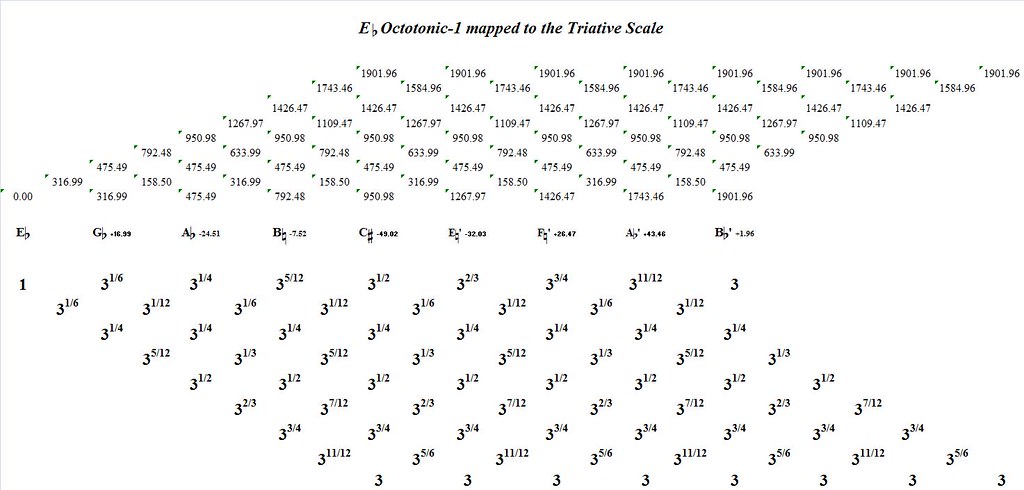
The intervallic content of the E Flat Octotonic-1 mapped to the Triative Scale.
 The Baltimore Symphony Orchestra @ The Joseph Meyerhoff Symphony Hall, Baltimore, MD
The Baltimore Symphony Orchestra @ The Joseph Meyerhoff Symphony Hall, Baltimore, MD"Because his music was rather conservative and tonally (or modally) oriented in a period when twelve-tone serialism was dominant, Yardumian never really caught on in the larger worlds of New York and Europe. But in our post-serial, neo-Romantic era, he seems ready for rediscovery."Post-serial, definitely. But I'd argue that this current era is post-neo-Romantic as well. While the beautifully tonal music of Richard Yardumian, Benjamin Britten, Jean Sibelius and many others were under appreciated and arguably suppressed under the intolerant attitudes associated with the serialist movement, the "post-serial" and "neo-Romantic" movements suggest supplanting one dogma with another as overcompensation. The unprecedented plurality of musics in an age of downloads that opens up a world of sound that crosses all boundaries of genre, culture and time suggests that this is in fact a post-dogmatic era. One that exposes the trunk of classical music that grew from Bach to Beethoven to Ives as but a single branch - a niche - within a vast interlocking network of great music. It is a good niche, worthy of celebrating. Even the warhorses. But the contemporary ear understands that a single concert season from any orchestra is only a grain of sand within a vast repertoire. It is good to rediscover the music Richard Yardumian. But let's not stop with timid forays into the early twentieth century and discover music composed just 50, 20 or even 2 years ago.

 Jack Wright/Katsura Kan & TROCKENEIS @ The Carriage House, Baltimore, MD
Jack Wright/Katsura Kan & TROCKENEIS @ The Carriage House, Baltimore, MD Peter Brötzmann/Han Bennink Duo @ An Die Musik, Baltimore, MD
Peter Brötzmann/Han Bennink Duo @ An Die Musik, Baltimore, MD The balance and range of territory explored by this pair carves a wide path of sound delivered in large slabs pouring from Brötzmann's alto and Bennink's drum kit.
The balance and range of territory explored by this pair carves a wide path of sound delivered in large slabs pouring from Brötzmann's alto and Bennink's drum kit. Wayne Horvitz/4+1 Ensemble: From A Window. 2001. Disk Union/Avan: 080.
Wayne Horvitz/4+1 Ensemble: From A Window. 2001. Disk Union/Avan: 080. Andrew Hill: A Beautiful Day. 2002. Palmetto Records: PM 2085.
Andrew Hill: A Beautiful Day. 2002. Palmetto Records: PM 2085. Anthony Braxton 12+1tet: 9 Compositions (Iridium) 2006 - disc 5. Firehouse 12 Records: FH12-04-03-001.
Anthony Braxton 12+1tet: 9 Compositions (Iridium) 2006 - disc 5. Firehouse 12 Records: FH12-04-03-001. Ornette Coleman: Sound Grammar. 2006. Sound Grammar: SG 11593.
Ornette Coleman: Sound Grammar. 2006. Sound Grammar: SG 11593. Tom Ze: Fabrication Defect: Com Defeito De Fabricacao. 1998. Luka Bop, Inc/Warner Bros.: 946953-2.
Tom Ze: Fabrication Defect: Com Defeito De Fabricacao. 1998. Luka Bop, Inc/Warner Bros.: 946953-2. Giacinto Scelsi: Natura Renovatur. 2006. ECM: 1963.
Giacinto Scelsi: Natura Renovatur. 2006. ECM: 1963. Audrey Chen/Frederic Blondy @ An Die Musik, Baltimore, MD
Audrey Chen/Frederic Blondy @ An Die Musik, Baltimore, MD
 Joe Lovano Ensemble: Streams of Expression. 2006. Blue Note Records: 946 3 41092 2.
Joe Lovano Ensemble: Streams of Expression. 2006. Blue Note Records: 946 3 41092 2.2005.jpg) Anthony Braxton Sextet: (Victoriaville) 2005. 2005. Victo: cd098.
Anthony Braxton Sextet: (Victoriaville) 2005. 2005. Victo: cd098. Ellery Eskelin: Vanishing Point. 2000. Hat Hut: hatOLOGY 577.
Ellery Eskelin: Vanishing Point. 2000. Hat Hut: hatOLOGY 577.
